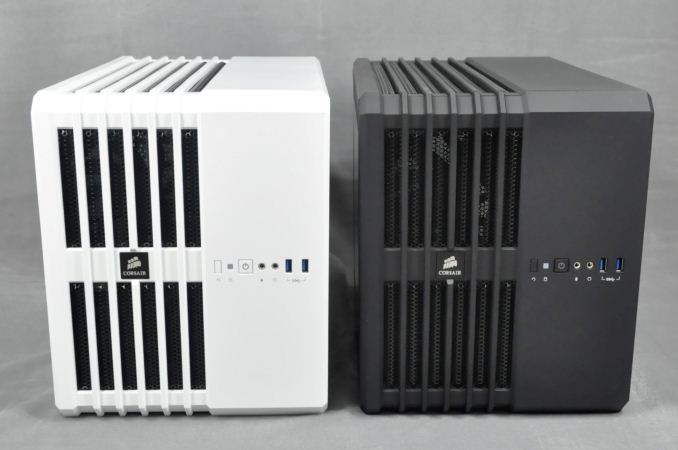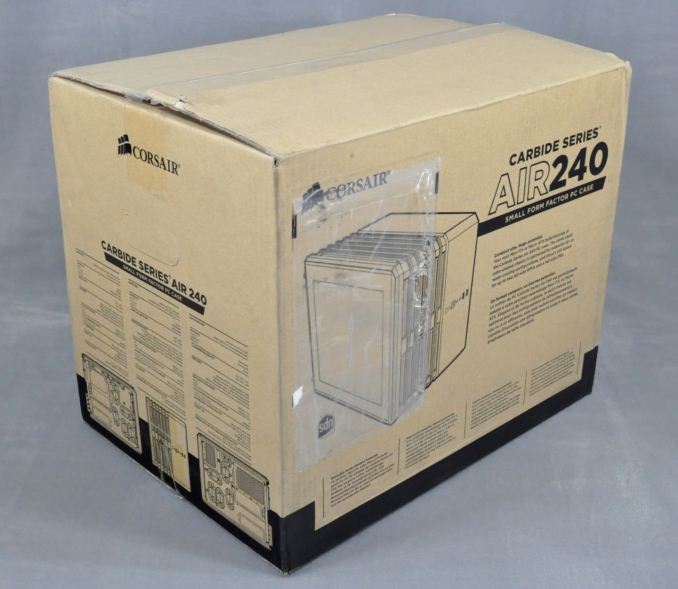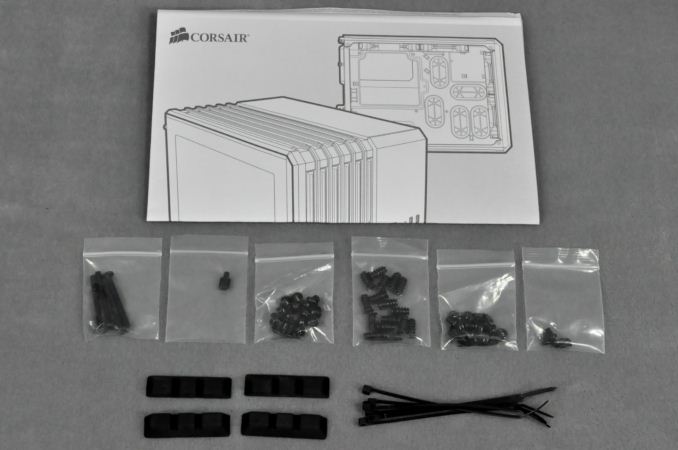Corsair Carbide Air 240 Case Review
by E. Fylladitakis on August 15, 2014 6:00 AM EST- Posted in
- Cases/Cooling/PSUs
- Corsair
- ATX
- Case
- Carbide

Introduction
Corsair is a company originally known for their quality RAM modules, but they have expanded into many other areas of the PC market. Today, Corsair is one of the most important players in the computer hardware market, with the company offering dozens of products, designed to cater to as wide an array of people as possible. Looking just at their computer cases, Corsair offers five series with an ever-expanding number of products, ranging from super-large cases for enthusiasts to low-cost products for budget-driven users. In this review, we will look at one of their latest case designs, the Carbide Air 240.
Compact cases and small form factors are all the rage nowadays. Some companies, such as Silverstone, have focused many of their R&D resources on the development of such designs. The first compact case that we reviewed from Corsair was the Obsidian 250D, a cubic Mini-ITX case of not so compact proportions; instead, it was designed to fit fairly powerful combinations of hardware. This is also true of the Carbide Air 240 that we will be reviewing today. Although it is designed to fit up to Micro-ATX motherboards, the Carbide Air 240 can accommodate very powerful hardware, including two top-tier GPUs and dual liquid cooling radiators. We will look at its design, features, strengths, and weaknesses in this review.
| Corsair Carbide Air 240 Specifications | ||
| Motherboard Form Factor | Mini-ITX, Micro-ATX | |
| Drive Bays | External | - |
| Internal |
3 x 2.5" or 3.5" (rear cage) 3 x 2.5" (top cage) |
|
| Cooling | Front | 2 x 120 (2 x 120mm included) |
| Rear | 2 x 80mm (optional) | |
| Top | 2 x 120mm (one included) | |
| Right Side | 1 x 120mm (optional) | |
| Bottom | 2 x 120 (optional) | |
| I/O Port |
2 × USB 3.0 2 × USB 3.0 1 × Headphone 1 × Mic |
|
| Power Supply Size | ATX | |
| Clearances | HSF | 125mm |
| PSU | 200mm | |
| GPU | 360 mm | |
| Dimensions |
~315mm × 265mm × 400mm (H×W×D) ~12.4in × 10.43in × 15.75in (H×W×D) |
|
| Pricing | ~$90 online | |
Packaging and bundle
The Corsair Carbide Air 240 comes supplied in a simple, brown cardboard box. The artwork on the box is limited to schematics of the case and text. Inside the box, the lightweight case is protected by thick polystyrene foam slabs and is wrapped in a nylon bag.
Corsair kept the items bundled with the Carbide Air 240 down to a minimum but organized them well, supplying each type of screw inside a separate nylon bag. There are also four rubber feet for the case and a few short cable ties.












63 Comments
View All Comments
HisDivineOrder - Sunday, August 17, 2014 - link
They take up too much space for too little gain. That space could be more 3.5" slots or even an open place for a fan.lexluthermiester - Wednesday, August 20, 2014 - link
Yup that's what he said. Wake up before you open your flap-trap.Etern205 - Friday, August 29, 2014 - link
I guess you haven't been old enough or encounter more, to know the nightmare it was to deal with external optical drives when they first arrived. I still remember when I had to use a external optical drive a few times to reinstall the OS on laptops where their internal optical drives had died or those that don't come with one. The problem is they're not that well built and the laptop itself as well as the bios also played a part.So this is what happens.
1. Not all USB ports plays nicely with USB optical drives, some will let it detect, but after a few minutes it mysteriously disconnects and then I had to power off the laptop and power it back on to let it find it again.
2. Some USB ports refuses to even detect any USB optical drives even after I changed to different brands, them USB cables, or even use one of those a internal optical drives connected via a SATA to USB adapter kit.
3. If I was lucky enough to begin the installation, I have to have my fingers crossed hoping the USB optical drive does not crap out during the middle of the installation and if it did, I have to restart the installation. The worst parts is finishing the installation up to 99% and then the USB optical drive craps out, so basically that's like a whole hour or so wasted for nothing.
4. Some laptops and USB optical drives have a mind of its own. they either want to work or don't work. With all these problems and weird behaviors, what used to be a simple install of the OS, has become a day of hell, just to get something that simple to complete, if their internal optical drive was working or it had one in the first place.
While they might have now improved, they had left a bad rep, therefore I still prefer a internal optical drive and cases should comes with at least one 5.25" bay. If you don't see the need to use a internal optical drive, then that 5.25" bay can be used for something else like adding a Hotswap SSD/HDD kit. or a LCD fan controller.
http://www.newegg.com/Product/Product.aspx?Item=N8...
I say Kill USB optical drives with fire and throw them stupid crap built laptops in alone with it.
Refuge - Friday, August 21, 2015 - link
I remember building in the 90's.To think external optical drives today are anything like the external drives of old, I guess you are just too old to build computers today?
Also back then, the simple work around was to take an internal drive, and just set it in the bottom of the case and hook it into the Mobo that way. I think you just lack imagination.
Kevin G - Friday, August 15, 2014 - link
I'll second the idea of additional 3.5" bays behind the motherboard. Also make them hot swap and then the case would be ideal for a DIY NAS or HTPC with redundant storage.lexluthermiester - Wednesday, August 20, 2014 - link
Totally with you!coburn_c - Friday, August 15, 2014 - link
Why do they ruin everything with garish plexy. Case windows should be an add-on option, industry wide.Infernus - Friday, August 15, 2014 - link
I agree, that's the only gripe I have with my 540 (and soon to be 240 when it eventually arrives).On a side note, I don't know why Apple doesn't offer the original NeXT Cube case in mATX/ATX format - I know I would pay good money for it.
notlurking - Friday, August 15, 2014 - link
Apple doesn't even have to do it! The NeXT Cube design patents expired years ago. I don't understand why, despite ten years of everyone saying they want a cube, that no manufacturer makes one. The next cube was 12"x12"x12" with a microATX sized motherboard, 1x3.5" bay and 1x5.25" bay.The 1x3.5" bay is need for SD slot or fan controller. Every laptop and All-in-one PC for the past ten years has had an SD slot yet only LianLi builds an SD slot in their case. The 1x5.25" bay is necessary because someone needs to do the rips that everyone else downloads.
Many people have bought NextCubes and modded them into PC's. I don't have time for modding but I'd pay for a 13"x13"x13" cube case.
The Carbide Air is so close to perfect, but I won't buy a 15.75" deep case that doesn't have a 5.25" bay.
zlandar - Friday, August 15, 2014 - link
The 12.4" height is too large to fit most entertainment consoles. My console has two fairly large shelves and the max height is 8.5". Not a ding since the author mentioned the case was not specifically designed for HTPC use but something to consider for people considering it.